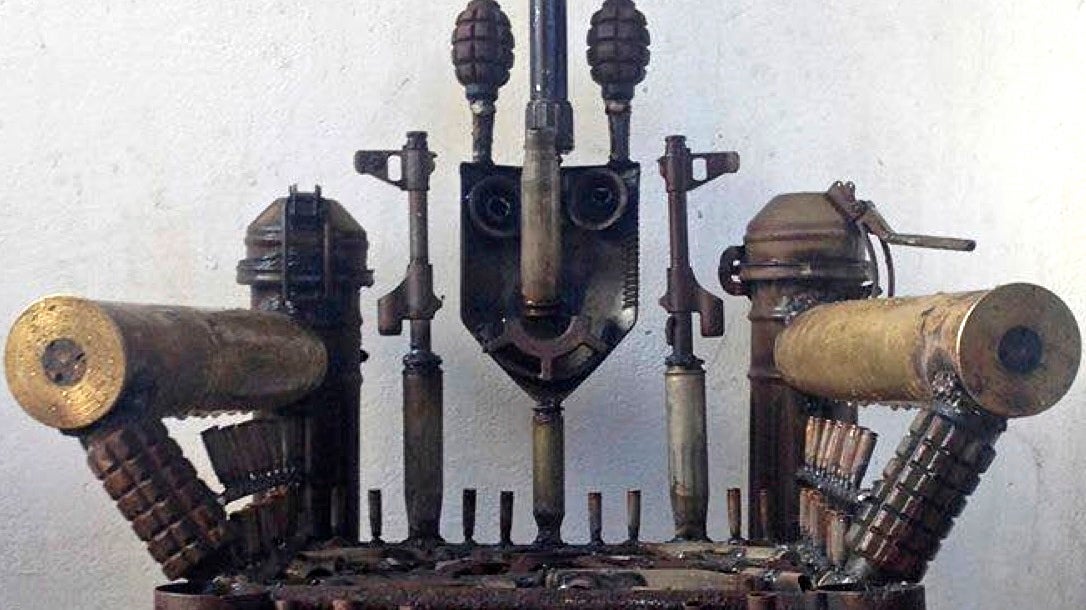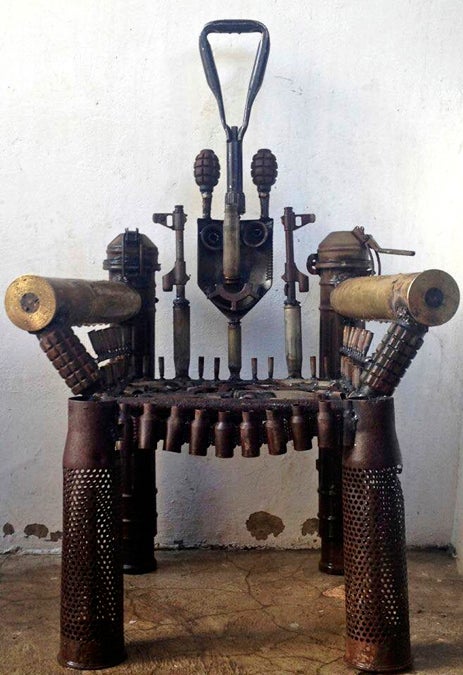Legal battle is joined over African sculpture of welded weapons
Listen
"War Throne," by African artist Goncalo Mabunda,was seized by U.S. Customs, which refuses to release it without a permit from the Bureau of Alcohol, Tobacco, Firearms and Explosives. (Photo provided by Adam Solow)
A piece of art shipped to Philadelphia from Africa is stuck in customs because of its unusual material. The sculpture is made entirely from guns.
“War Throne” was made by Goncalo Mabunda, an artist from Mozambique who welds decommissioned weapons used during the 15-year civil war in Mozambique from 1977 to 1992. His chairs bristle with rifle parts, hand grenade casings, mortar shells, bullet shells, and the barrels of large-caliber artillery.
One of his chairs caught the eye of Adam Solow, a Philadelphia attorney who collects African art for its vibrant color and political messaging.
“He’s taking things that were used to kill and maim, and trying to reconstitute them into objects of beauty,” said Solow. “Or, to make you think about things that happened in his country, and moving on from that war.”
 “War Throne,” by African artist Goncalo Mabunda, uses decommissioned weapons from the Mozambique Civil War. (Photo provided by Adam Solow)
“War Throne,” by African artist Goncalo Mabunda, uses decommissioned weapons from the Mozambique Civil War. (Photo provided by Adam Solow)
Solow bought one of Mabunda’s “War Thrones” through an overseas dealer for $8,200. When it arrived at a Philadelphia port, it triggered red flags with U.S. Customs. Officials turned the chair over to the U.S. Bureau of Alcohol, Tobacco, Firearms and Explosives, which told Solow that parts of the chair must be destroyed because they can be reconstituted as firearms.
“I don’t see how this can be classified as a firearm,” said Solow. “I don’t know how I can use this as a firearm in any way, unless I was a Transformer.”
Anthony Tropea, an ATF special agent in Philadelphia, said that as long as parts can be removed and repurposed as weaponry, the chair is a threat.
“For example, those two grenades on top of this particular piece of art, if they can be removed mechanically, and somebody obtains a powder — an explosive powder — this device would no longer be inert, it would become an explosive device,” said Tropea.
In a letter to Solow, the ATF said it would release the chair only through a licensed arms importer. Even then, certain parts of the chair would have to be destroyed beyond recognition.
Other chairs by Mabunda have been shipped without incident to New York City, where he is represented by Ethan Cohen Fine Arts. The Brooklyn Museum has one on display.
Solow plans to file a suit in federal court this week to force the ATF to release the chair, arguing the chair does not comply with the federal government’s own definition of what constitutes a firearm.
“The definition of firearm under federal law says certain things that appear to be firearms are not classifiable as firearms for federal purposes,” said Alex Isbell, a partner at Solow’s law firm filing on his behalf. “That includes things the attorney general has determined are not likely to be used as a weapon, and that includes something that may be a weapon but is only used for cultural purposes.”
If he is not allowed to have the chair, Solow said he would rather donate it to the museum than destroy it per ATF regulations.
WHYY is your source for fact-based, in-depth journalism and information. As a nonprofit organization, we rely on financial support from readers like you. Please give today.





